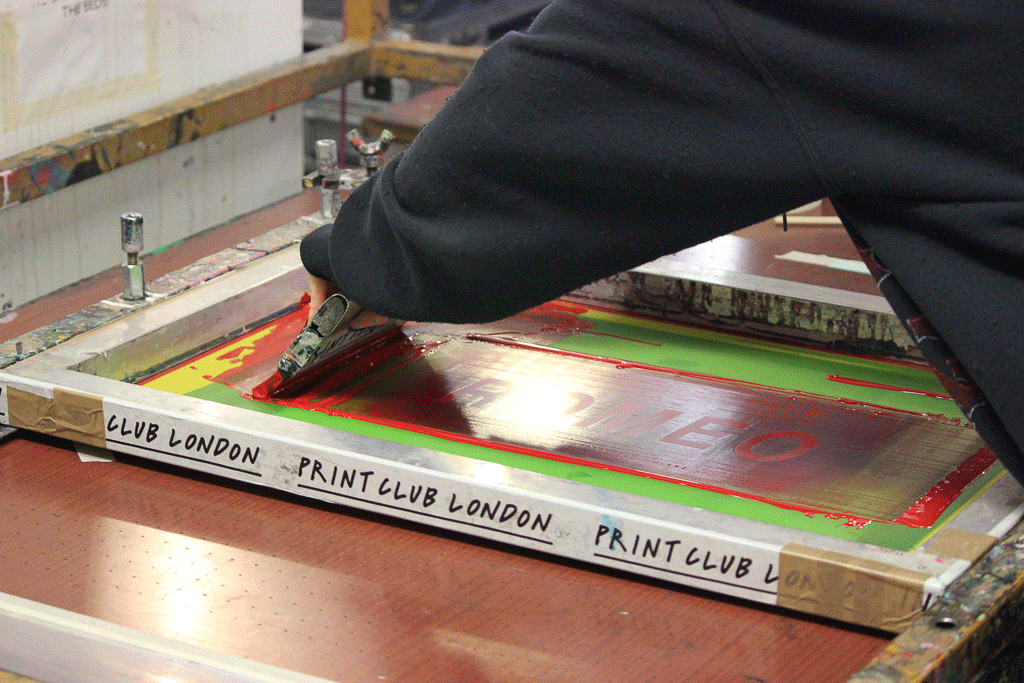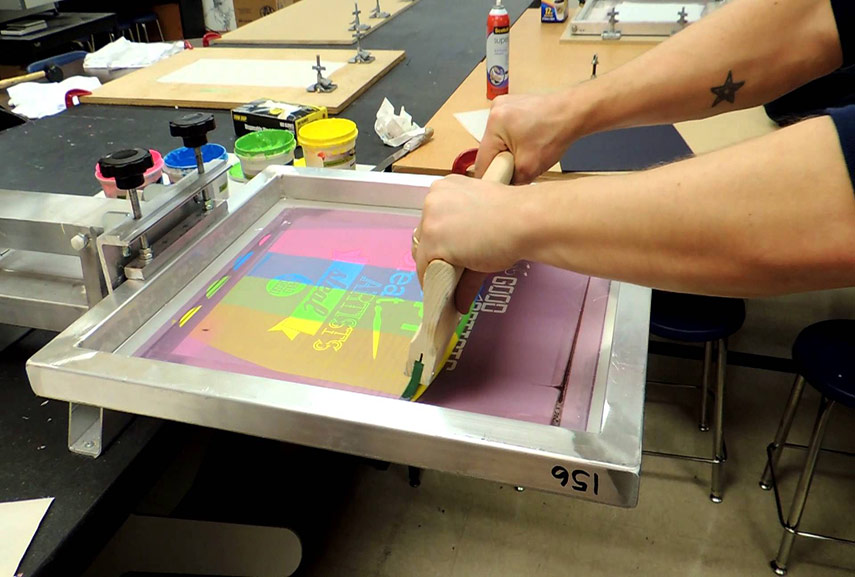Discover the Various Kinds Of Screen Printing Techniques for Your Next Job
Screen printing uses a diverse variety of techniques that can improve any innovative project. From standard approaches like serigraphy to modern technologies such as direct-to-garment printing, each approach has its one-of-a-kind benefits. Specialty options, consisting of eco-friendly and metallic inks, introduce much more opportunities. Comprehending these strategies can significantly influence the final result. The obstacle exists in selecting the most ideal approach for specific requirements and preferred impacts. What variables should one consider?

The Basics of Screen Printing
Screen printing may seem complicated, it is basically a straightforward process that involves transferring ink via a mesh screen onto numerous surfaces. The strategy starts with the development of a pattern, which specifies the style to be published. This stencil is connected to a mesh screen, usually made from polyester or nylon. Once the pattern is in location, ink is put on the screen and pressed through the mesh making use of a squeegee, leading to the preferred pattern being published on the underlying material.
Screen printing can be executed on a wide array of substratums, consisting of plastic, material, and paper, making it a functional selection for various projects. The process permits intricate styles and vibrant shades, making it prominent in sectors such as style, marketing, and art. Understanding these basics furnishes individuals with the fundamental knowledge required to explore advanced strategies in screen printing.
Typical Screen Printing Techniques
Traditional screen printing techniques have actually been utilized for centuries, maintaining the workmanship and artistry of this technique. This approach uses a mesh screen to transfer ink onto a substrate, such as textile or paper, enabling lasting and lively designs. The procedure begins with developing a stencil, which obstructs specific areas of the screen to manage where the ink will be used.
One prominent strategy is serigraphy, usually utilized for minimal editions and creative prints. An additional is making use of water-based inks, which are environmentally friendly and give a soft feeling on fabrics - 10:9 Design LLC Company. Furthermore, typical methods can include manual printing, where craftsmens apply ink with a squeegee, making certain accuracy and interest to detail
These techniques stay valued in the sector for their responsive top quality and the distinct textures they produce, appealing to both developers and customers that appreciate the heritage of screen printing.
Digital Screen Printing Innovations
As the need for faster manufacturing and customization in the printing sector has surged, electronic screen printing advancements have actually emerged as a game-changer. This modern technology mixes standard screen printing approaches with digital processes, enabling quick prototyping and intricate designs that were previously challenging to achieve. One significant improvement is the introduction of direct-to-garment (DTG) printing, which helps with high-grade, full-color prints on numerous fabrics without the requirement for screens. In addition, innovations in ink formulations have caused environment-friendly choices that maintain dynamic shades while decreasing environmental effect. The use of automated systems additionally streamlines manufacturing, reducing labor costs and boosting accuracy. These innovations not only cater to tiny set orders and tailored styles yet additionally enable for quicker turnaround times, making them excellent for services concentrated on conference customer demands in a hectic market. Digital screen printing, as a result, stands for a vital evolution in the domain of printing techniques.
Specialty Screen Printing Methods
Exploring specialized screen printing approaches discloses a diverse range of methods that push the limits of imagination and performance in the printing sector. Among these, glow-in-the-dark inks give an one-of-a-kind aesthetic effect, making layouts come alive in low-light conditions. Metal inks, understood for their shimmering surface, include a touch of high-end to published materials. An additional innovative technique is discharge printing, which gets rid of dye from the textile rather than adding ink, leading to a soft, vintage feeling. High-density printing produces a raised structure externally, enhancing tactile interaction. In addition, water-based inks are acquiring popularity for their vibrant colors and minimized ecological influence. Each of these specialty methods satisfies details design requirements, making it possible for brands and musicians to produce standout products that reverberate with their audiences. By leveraging these methods, organizations can elevate their screen printing tasks to new elevations, ensuring memorable impacts.
Eco-Friendly Screen Printing Options
Green screen printing alternatives are obtaining traction as the sector shifts in the direction of sustainability. Sustainable ink selections and using eco-friendly products are vital components in lowering the ecological impact of the printing process. By taking on these methods, screen printers can contribute to an extra lasting future while maintaining top quality outcomes.
Lasting Ink Options

Biodegradable Products Use
As the screen printing industry evolves, the incorporation of biodegradable materials is coming to be significantly vital for environmentally mindful practices. Producers and designers are now exploring inks and substratums made from all-natural, renewable energies that decay more efficiently than standard equivalents. These eco-friendly alternatives decrease plastic waste and reduce environmental impact, aligning with the expanding need for lasting items.
Common examples consist of water-based inks and natural cotton fabrics, both of which minimize unsafe chemicals and promote eco-friendliness. Brand names that embrace these materials typically improve their market charm, bring in consumers that prioritize sustainability. As recognition of environmental issues remains to rise, the change towards eco-friendly materials in screen printing is likely to acquire momentum, fostering a greener sector requirement.
Picking the Right Method for Your Project
Just how can one determine the most ideal screen printing strategy for a particular project? The decision depends upon numerous elements, including the product to be printed on, the intricacy of the layout, and the wanted manufacturing quantity - 10:9 Design contact. Direct-to-garment printing is perfect for intricate layouts with countless colors, while standard screen printing excels for bigger runs of less complex graphics.
Furthermore, factor to consider of the end-use of the printed product is crucial. For outside applications, methods that offer sturdiness and climate resistance, such as plastisol ink, might be favored. On the other hand, environmentally-conscious tasks may profit from water-based inks or eco-friendly products.
Ultimately, understanding the task's special needs permits an enlightened choice, guaranteeing both aesthetic charm and functional longevity. By evaluating design complexity, material compatibility, and manufacturing range, one can efficiently pick one of the most ideal screen printing strategy to satisfy their job's objectives.
Often Asked Questions
What Is the Background of Screen Printing?
Screen printing came from in old China around 1000 ADVERTISEMENT, evolving via Japan and Europe. By the 20th century, it became preferred in business art and style, revolutionizing exactly how designs were produced and dispersed internationally.

Exactly how Do I Prepare Art Work for Screen Printing?
To prepare artwork for screen printing, one should ensure high resolution, utilize an ideal color setting, develop different layers for every shade, and transform text to lays out, guaranteeing compatibility with the printing procedure and wanted result.
What Materials Are Ideal for Screen Printing?
The very best products for screen printing consist of high-grade inks, resilient displays, and appropriate substratums like cotton, polyester, or blends. Additionally, using suitable solution and squeegees can improve the printing procedure and outcomes.
Can I Evaluate Print in the house?
Yes, screen printing in the house is feasible. With the appropriate materials, setup, and methods, individuals can produce top quality prints. However, careful factor to consider of office and devices is vital for successful results.

What Are Common Mistakes in Screen Printing?
Typical errors in screen printing include incorrect direct exposure times, poor ink uniformity, imbalance of displays, inadequate cleaning of materials, and disregarding to test prints. These mistakes can jeopardize the high quality and accuracy of the end product.
Screen printing might seem complex, it is fundamentally a simple process that includes transferring ink through a mesh screen onto numerous surfaces. As the demand for faster manufacturing and customization in the printing industry has actually risen, digital screen printing advancements have actually emerged as a game-changer. Exploring specialized screen printing methods exposes a diverse array of techniques that push the borders of imagination and functionality in the printing check here sector. The ideal materials for screen printing include premium inks, sturdy screens, and suitable substrates like cotton, polyester, or blends (10:9 Design near me). Usual mistakes in screen printing consist of incorrect direct exposure times, insufficient ink uniformity, misalignment of displays, inadequate cleaning of products, and neglecting to evaluate prints